Mastering Charcoal Grilling: A Complete Guide
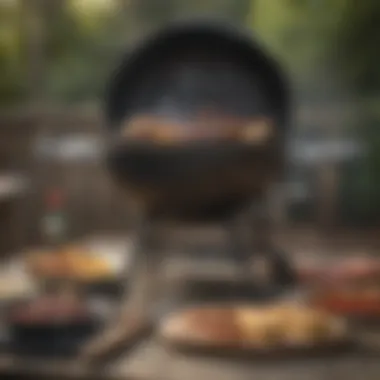
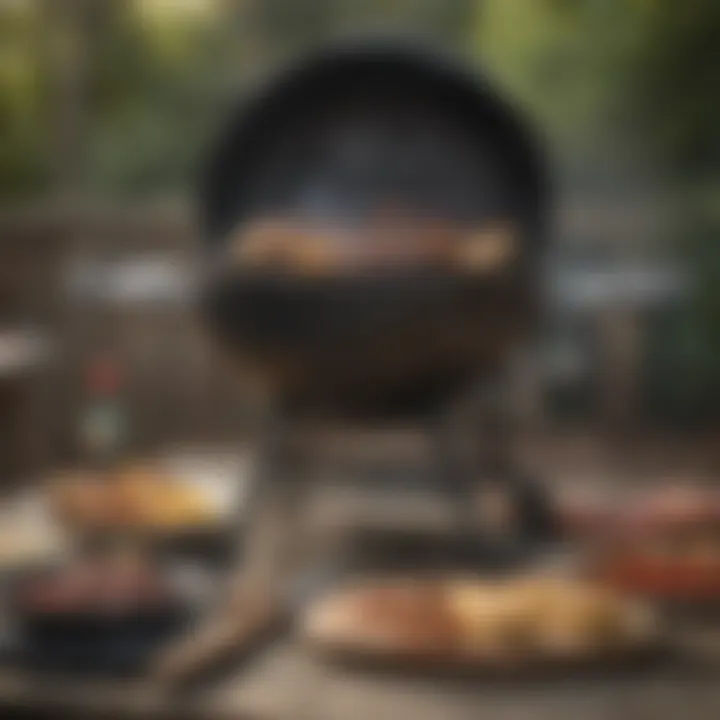
Intro
When it comes to outdoor cooking, the allure of charcoal grilling is hard to resist. This method transforms simple ingredients into mouth-watering meals, inviting friends and family to gather around a smoky aroma that brings memories etched in flavor. With each sizzle and sear, charcoal grilling is more than preparing a meal; it’s about creating an experience.
Grilling with charcoal, however, isn’t just about the meat hitting the grates. It's a dance of heat, flavor, and time. From selecting your grill to choosing the right charcoal, every choice matters. This guide is your compass in navigating the rich world of charcoal grilling, aiming to boost your skills while helping you avoid rookie mistakes.
Whether you are a seasoned pro or a novice trying to impress at your next backyard BBQ, understanding the nuances of charcoal grilling can elevate your culinary game. Let’s dive into the essentials of this delicious art form.
Understanding Charcoal Grills
To truly master the art of grilling, one must first appreciate the very essence of the charcoal grill. This understanding forms the backbone of any successful grilling venture. Charcoal grilling is not just about cooking food over flames; it's a dance between heat, smoke, and flavor. By grasping what charcoal grilling entails, enthusiasts can elevate their outdoor cooking experience, ensuring that every meal is not only delicious but unforgettable.
Defining Charcoal Grilling
Charcoal grilling refers to the method of cooking food over hot charcoal, utilizing its radiant heat to sear and cook various ingredients. The process is an age-old technique, with roots that stretch back centuries. When you light up a charcoal grill, you’re not just igniting briquettes; you are tapping into a deep culinary tradition. The flavor produced by burning charcoal is distinct and hard to replicate with other grilling methods, making it a revered approach among many home cooks.
However, it's vital to understand the dynamics at work when grilling with charcoal. The intensity of the heat can vary, influenced by factors such as the type of charcoal used, airflow, and how you set up your grill. This variability can yield different cooking results. Moreover, charcoal produces smoke, which adds another layer of flavor to foods, particularly meats, that no gas grill can match. When seasoned properly, foods cooked over charcoal take on a unique taste that tantalizes the palate.
Benefits of Charcoal Grilling
Charcoal grilling has its fair share of advantages. A few key benefits that set it apart from other methods include:
- Flavor: The distinct smoky flavor imparted by charcoal is unmatched. This enhances meats, vegetables, and even fruits, transforming them into culinary masterpieces.
- Temperature Control: Charcoal grills allow for precise temperature management, a skill that can be honed over time. Adjusting the air vents influences the heat, giving you control over how you cook.
- Versatility: Charcoal grills are capable of a range of cooking methods, from searing to slow-roasting. You can turn up the heat for a quick steak or maintain low temperatures for melting dishes.
- Affordability: Charcoal grills are generally more budget-friendly compared to their gas counterparts. They provide a cost-effective entry point for novice grillers.
"Charcoal grilling is about patience, precision, and passion." - Anonymous
The exploration of charcoal grilling does not simply end here; understanding its nuances leads to more flavorful results, transforming a simple meal into an experience. Thus, getting to grips with charcoal as well as its properties lays the foundation for a rewarding grilling journey.
Choosing the Right Grill
Selecting the appropriate grill is a foundational step in the charcoal grilling process. It's not just about picking what looks good in the backyard; it’s about figuring out what best meets your cooking needs, lifestyle, and preferences. A practical approach here can greatly enhance your grilling experience. With various types of grills available, understanding their features and functions helps make an informed decision.
Types of Charcoal Grills
Each type of grill brings something unique to the table. Here’s a closer look at the three most prominent types you might consider:
Portable Grills
Portable grills are designed for convenience and ease of transport, making them an ideal choice for those who love to host barbecues in different locations, such as parks or tailgating events. They can often be folded down and stored away when not in use, which is a big plus for folks short on space. A key characteristic of portable grills is their lightweight design and compact size.
However, keep in mind that the smaller cooking surface area can limit the amount of food you prepare at one time. So, if you're planning on a big gathering, you may find them a bit lacking in capacity. Still, if your aim is versatility without much hassle, portable grills usually do the trick well.
Kamado Grills
Kamado grills have gained quite a reputation due to their ability to maintain consistent temperatures for long periods. Their thick ceramic construction helps with heat retention and distribution, making them highly efficient. A noteworthy characteristic of kamado grills is their versatility—they can be used for grilling, smoking, baking, and roasting. Friends of the kamado grill rave about how it can achieve low-and-slow cooking as effectively as it can sear steaks.
However, this efficiency often comes with a heftier price tag, and their weight makes them less portable compared to other options. If you value flexibility and are willing to invest in quality, kamado grills might be the way to go.
Traditional Kettle Grills
Traditional kettle grills are the classic choice, often seen as the workhorse of outdoor cooking. Their round shape enables even heat distribution and they are usually quite affordable. This type of grill is ideal for beginners and frequent grillers alike, thanks to its straightforward design and setup.
One key advantage of kettle grills is their simplicity. Most models are easy to assemble and use, making them particularly appealing for those new to grilling. On the flip side, they can be less effective for long cooking sessions without regular attention to the coals, which some might find tedious.
Key Features to Consider
As you venture into selecting your grill, there are salient features to keep in mind, ensuring the chosen model fits your grilling ambitions well.
Material and Durability
When it comes to material and durability, this aspect can’t be understated. A grill made of high-quality steel or ceramic will withstand the test of time much better than thinner materials. Durability reflects the capacity to endure the repetitive heat exposure and outdoor weather conditions. Investing in a well-constructed grill can save money in the long run, avoiding the need for frequent replacements.
But, with durability often comes added weight. This can make moving the grill cumbersome, so consider your level of mobility needs while making a decision.
Size and Cooking Area
The size and cooking area of the grill are crucial; a larger grilling area allows for cooking multiple items at once. If you often find yourself hosting gatherings or family cookouts, this is something to prioritize. A compact grill might suit those who grill less frequently or have limited outdoor space, but it can become a challenge during larger events. Choosing the right size aligns directly with your cooking habits and the number of people you typically serve.
Airflow Control
Airflow control is another critical feature that contributes to heat management. A grill with adjustable airflow vents allows you to fine-tune your cooking temperature effectively, which is essential for achieving that perfectly seared steak or smoked brisket. A well-designed airflow system can significantly enhance your grilling experience by allowing greater control, though it may be slightly more complex to get the hang of initially.
Tip: Familiarizing yourself with airflow adjustments can drastically improve your grilling results.
Selecting Charcoal
Choosing the right charcoal is paramount when it comes to mastering the art of grilling. The type of charcoal you select has a significant impact on the flavor, heat, and cooking time of your food. In fact, picking out your charcoal isn’t just about making a choice; it’s about setting the stage for a culinary experience. Different charcoals provide different levels of heat and distinct flavors that can elevate your grilling game.
Types of Charcoal
When discussing types of charcoal, there are three main options that have carved out their own niches. Each type has its own merits, which can influence not only how your food cooks but the taste it imparts as well.
Briquettes
Briquettes are widely recognized in the grilling world, often found in many backyard setups. One of the main characteristics of briquettes is their consistent size, which promotes even heating. They are made by compressing charcoal dust with binders, enabling them to hold their shape quite well.
Advantages of briquettes include:
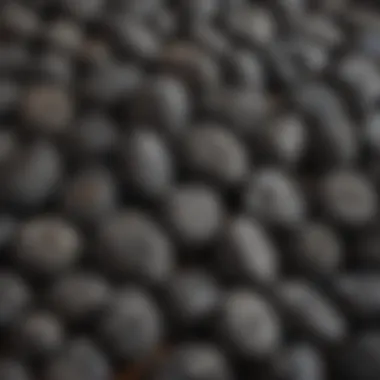
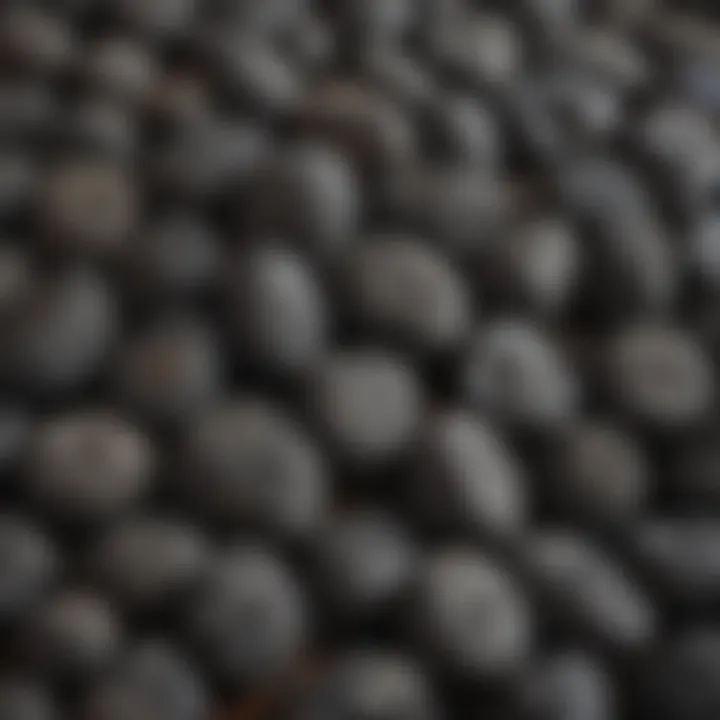
- Ease of Use: Because they burn steadily and predictably, they are beginner-friendly.
- Cost-Effective: Generally, they are less expensive than lump charcoal.
- Long Burn Times: They can take a bit longer to heat but can maintain high temperatures for extended periods.
However, bear in mind that they can contain chemicals from binders, which may impact the flavor slightly.
Lump Charcoal
Moving on to lump charcoal, this stuff is the real deal for those who prioritize natural grilling. Unlike briquettes, lump charcoal is made from pure wood that has been carbonized. One of its standout features is that it ignites quickly and burns hotter than briquettes, usually hitting those high temperatures in a shorter time frame.
Key reasons to consider lump charcoal include:
- Flavor Preservation: It offers a more natural, authentic taste because it lacks additives.
- Higher Temperatures: Great for searing; it can reach temperatures upwards of 1,200°F, providing that perfect sear on steaks.
- Less Ash Production: It generates less ash, making cleanup a breeze.
On the flip side, it can burn faster than briquettes, which necessitates closer attention while grilling.
Flavored Charcoal
Flavored charcoal is where creativity meets grilling. This type of charcoal is often infused with natural woods like hickory or mesquite, bringing unique nuances to your food.
What makes flavored charcoal appealing?
- Enhanced Taste: It infuses your meats and veggies with complex flavors that are hard to replicate with standard charcoal.
- Distinct Aroma: The smell of flavored charcoal adds a sensory element, enhancing the grilling experience.
However, it’s worth noting that sometimes the flavor can overwhelm more delicate items, so it’s wise to use it judiciously.
Lighting Charcoal Efficiently
With the right charcoal selected, the next step is lighting it efficiently. Proper lighting techniques minimize frustration and ensure that the grill reaches the desired temperature for optimal cooking.
Using a Chimney Starter
One popular method to light charcoal is by using a chimney starter. This tool is straightforward and allows for an efficient lighting process without chemical lighter fluids.
The benefits of using a chimney starter include:
- Quick Ignition: Charcoal ignites evenly, producing steady flames without the need for chemicals.
- User-Friendly: Simple design means less fuss while starting your grill.
On the downside, you need to be cautious as the chimney gets hot, and handling it requires heat-resistant gloves.
Alternative Lighting Methods
If a chimney starter isn't handy, there are alternative lighting methods that can be quite effective. These can include using lighter cubes or natural fire starters like paper wrapped in loosely crumpled up newspaper.
Some characteristics of alternative lighting methods encompass:
- Versatility: You can use various materials, making them adaptable to what's available.
- No Special Equipment: Often requires just what you have at home, handy for spontaneous grilling scenarios.
Nevertheless, the trade-off usually comes in terms of longer ignition times, demanding patience while waiting for the charcoal to catch.
In the world of charcoal grilling, the key is to experiment and find the combinations that best fit your unique grilling style.
Preparing to Grill
Grilling isn’t just about tossing meat on heat and crossing your fingers. The preparation phase is crucial to achieving both flavor and texture. You can think of it as the bridge between raw ingredients and the finished dish you serve. This stage lays the groundwork for successful cooking on a charcoal grill. It’s about ensuring everything is ready so that when the time comes, you can execute flawlessly without scrambling.
Setting Up the Grill
Before you even think about putting any food on the grill, it’s essential to get the grill itself ready. First things first, clean it if it’s been sitting unused for a while. Dust off the grime and residue from previous grilling sessions; nobody wants yesterday's charred remains mingling with today’s meal. Use a grill brush for smooth surfaces, making sure to scrub those grates properly.
Once it's clean, check the charcoal level and ensure there’s enough to cook your intended meal to completion. The arrangement of the charcoal is as important as the type of coal you’ve selected. Place the briquettes or lump charcoal in a pattern that suits your cooking style, ensuring there’s room for air to circulate freely; more oxygen means better heat and a more stable cooking experience.
Achieving the Right Temperature
Temperature control can make or break a grilling event. You want to have a good grasp of how to manipulate heat, as it determines how your food cooks. Charcoal grilling allows you to achieve high temperatures needed for searing, but also the ability to slow-cook foods at lower temperatures. Understand these two basic concepts will enhance your experience.
Direct vs. Indirect Heat
The choice between direct and indirect heat typically depends on what you’re cooking. Direct heat involves placing your food right over the hot coals, which is fantastic for searing meats like steaks or chicken. You get that beautiful brown crust, which many people crave. However, this method has its pitfalls—too much direct heat can lead to burnt outsides and raw insides.
Indirect heat, on the other hand, places your food away from the coals. This sets up a slow-cooking environment where meats can tenderize and absorb flavors without the danger of burning. It’s particularly useful for larger cuts like whole chickens or ribs. Both styles have their unique charms and challenges, but mastering when to use either can take your grilling to the next level.
Temperature Management Techniques
Managing temperature involves regular checks throughout the grilling process. One method is simply to use a thermometer, which takes the guesswork out of it. Invest in a good instant-read thermometer for this job. It’s surprisingly easy to keep tabs on doneness this way.
Another technique is the hand test—hold your hand above the grill (be cautious!) and gauge the heat; you can determine whether it’s low, medium, or high based on how long you can comfortably hold your hand there. Also, familiarize yourself with the grill’s hot spots, which can drastically influence cooking times.
Be aware that both external factors, like wind or humidity, and internal factors, such as how much food is on the grill, can affect your heat levels. A consistent grasp on temperature management will yield better results almost every time.
Understanding your grill’s dynamics will lead you to deliciously grilled meals with minimal headaches.
Preparation ensures that you can focus on creating beautiful dishes rather than worrying about the mechanics of your grill. Confident grilling doesn’t begin when the food hits the grates; it starts long before that.
Grilling Techniques
Grilling techniques are the lifeblood of charcoal grilling. They dictate not just the flavor but also the overall experience you create with your grill. Using various techniques can elevate your cooking, making even the simplest ingredients shine. Understanding and mastering these methods contribute significantly to that smoky goodness and enhances your culinary confidence. Here, we will break down basic and advanced techniques, giving you tools to perfect your approach.
Basic Grilling Methods
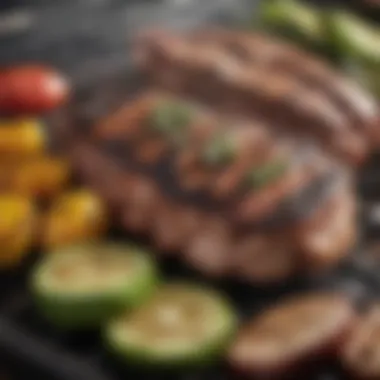
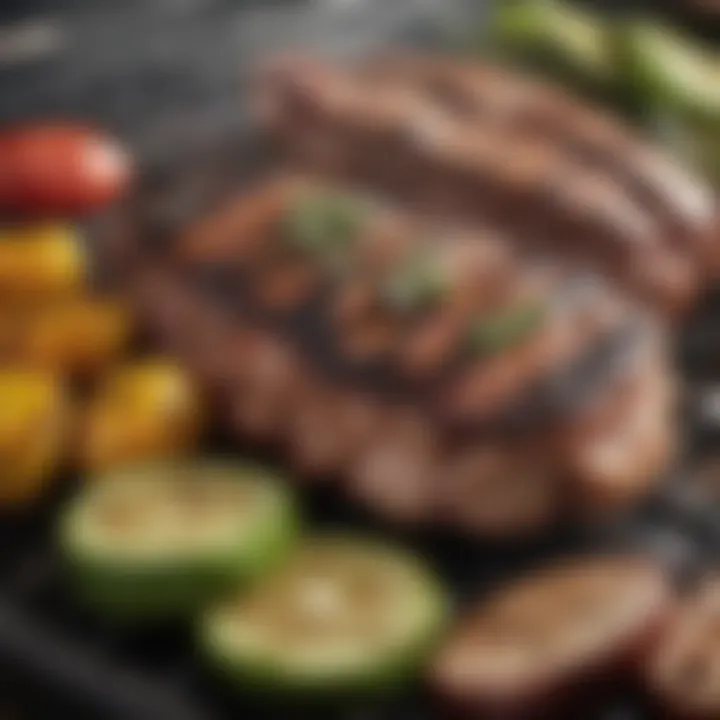
Searing
Searing is one of the most fundamental techniques in grilling. It involves cooking food at a high temperature to create a crispy, caramelized exterior, which locks in moisture for a juicy inside. For red meats like steaks, this method delivers a mouthwatering crust that many grill aficionados cherish.
One attractive aspect of searing is its ability to create layers of flavors. The Maillard reaction kicks in here, which is essentially the browning process that develops those rich flavors. This method is popular because it’s straightforward, yet immensely satisfying. It can also be adapted for vegetables, giving them that charred yet tender finish.
However, it’s important to note that the timing is crucial. If you sear too long, you risk producing a tough piece of meat. The sweet spot lies in practicing your timing as well as maintaining an evenly heated grill. This practice can make all the difference in mastering searing.
Flipping and Rotating
Flipping and rotating is another basic method that often gets overlooked. This technique involves turning your food over, as well as rotating it on the grill to ensure even cooking. It's essential for achieving that perfect doneness without burning one side.
When you flip and rotate, you prevent the food from sticking, which helps to keep it moist. You'll find this particularly beneficial when grilling delicate proteins like fish, which can easily fall apart if not treated gently. A key characteristic of this technique is its simplicity; there are no fancy gadgets or tools required — just a good set of tongs.
Still, caution is needed. Frequent flipping can interrupt the searing process, leading to a less flavorful crust. So, find that balance between letting your food sit and knowing when it’s time to give it a turn.
Advanced Techniques
Smoking
Smoking is an advanced technique that adds another layer of flavor and depth to your grilled meals. It involves using wood chips or chunks to infuse that rich, smoky essence into your food. This method can take time, but the results are often worth the wait. Choosing the right wood type, like hickory, mesquite, or applewood, can create varied flavors that match well with different foods.
One of the key benefits of smoking is versatility. From meats to vegetables, almost anything can undergo this flavorful transformation. However, it’s good to remember that smoking tends to take longer than typical grilling, so some patience is a must. Make sure to monitor your temperature closely to prevent overcooking while still achieving that sumptuous smokiness.
Grilling on a Plank
Grilling on a plank might seem unconventional at first but it offers an intriguing technique that many would benefit from trying. This method typically uses cedar or other types of wood, which adds unique flavors to your food. The plank protects food from direct heat, which allows it to cook evenly while absorbing that subtle wood taste.
What makes this technique appealing is how it elevates simple meals into something extraordinary. Cooking fish or chicken on a plank can yield moist results with an added hint of the wood's character. The plank also keeps the food moist by trapping steam, another plus in this technique’s favor.
However, there are challenges. Not every plank can withstand the heat, so ensure you’re using a food-safe option designed for grilling. Plus, the setup may require some adjustments in cooking time, as it doesn't offer that quick sear like traditional grilling methods.
Both basic and advanced grilling techniques play a crucial role in maximizing flavor while ensuring safety and quality for your dishes. The real mastery comes from practice — don’t be afraid to experiment and find what works best for you!
In essence, mastering grilling techniques can elevate your cooking game immensely, turning each grilling session into a delightful culinary adventure. As techniques blend and evolve with your personal style, the results will undoubtedly wow your guests and family alike.
Food Preparation and Marinades
The art of charcoal grilling isn't just about getting the heat just right; it's equally about the meticulous preparation of the food that graces the grill. Food preparation and marinades are genuinely the unsung heroes of a successful grilling experience. Starting with the right ingredients sets the stage for flavor, tenderness, and overall satisfaction. Whether you’re going for some juicy steaks or vibrant veggies, every detail matters when it comes to enhancing the natural tastes and textures of what you’re grilling.
By selecting high-quality ingredients, you can ensure your meals burst with flavor and show off the craftsmanship you put into them. The choices you make about marinades and seasonings can elevate plain meat and vegetables into culinary masterpieces. This section will explore which elements to consider when selecting your ingredients and how to concoct effective marinades that will leave a lasting impression.
Choosing the Right Ingredients
When it comes to grilling, fresh and high-quality ingredients make all the difference. Choosing meats that are well-marbled, fresh cuts of poultry, or seasonal vegetables can enhance not only the taste but also the experience of grilling itself. Here are a few things to keep in mind:
- Freshness: Whenever possible, pick up your ingredients from local markets or butchers. Fresh produce and meats will always have a more pronounced flavor than their less fresh counterparts.
- Quality: Select meats that are organic or grass-fed if achievable. These options often offer better flavor and are typically more sustainable.
- Variety: Expand your horizons beyond traditional meats. Consider grilling fruits, such as pineapples or peaches, for a different flavor experience that complements your main dishes.
Taking these factors into account can change a simple meal into something your friends and family will rave about long after the last bite.
Marinades and Seasonings
A well-crafted marinade not only infuses food with flavor but also tenderizes tougher cuts of meat, making them juicy and delicious. The right balance of spices, acidity, and oil is key to creating marinades that work wonders. Let’s delve into two essential aspects of marinades: creating flavor profiles and timing for marinating.
Creating Flavor Profiles
Creating distinct flavor profiles is where your creativity can truly shine. The essence of a great marinade revolves around balancing different elements:
- Acid: Whether using vinegar, citrus juice, or yogurt, acids help tenderize meat and bring brightness to the flavor.
- Oil: Oils help carry flavors into the food. Olive oil is a popular choice, but exploring other oils—like sesame or avocado—can add unique twists.
- Herbs and Spices: Fresh herbs, garlic, and spices tie the whole profile together. Experiment with what you have on hand!
The beauty of crafting flavor profiles lies in its adaptability. You can mix and match ingredients based on what’s in season or your personal preferences. Just keep in mind that achieving a balance is crucial; too much of any one ingredient can overpower the others.
Timing for Marinating
Timing is a crucial factor when marinating. Not allowing enough time can lead to lackluster flavors, while overdoing it can result in mushy textures. Here’s what to know:
- Quick Marinades: A 30-minute soak can enhance flavor for lighter proteins like fish or chicken. The quick soak helps add flavor without overwhelming the meat's texture.
- Longer Marinades: For meats like beef or pork, marinating for several hours, preferably overnight, allows deeper flavor penetration. Just be cautious not to exceed the window, as this can lead to undesirable textures.
Finding that perfect balance of timing and flavor will help you link technique to results on the grill.
Choosing the right ingredients and marinades not only affects flavor but also the entire grilling experience. Well-prepared foods lead to memorable meals.
In summary, the steps taken in food preparation and the marinades you create can define the quality of what you throw on the grill. It’s a realm in which every choice counts, and investing time in crafting your ingredients and flavors can make all the difference between decent and exceptional results.
Safety Considerations
When engaging in the process of charcoal grilling, safety should always take center stage. This area of grilling not only safeguards the chef and guests but also ensures that the culinary creation runs smoothly and according to plan. Ignoring safety can lead to accidents, injuries, or ruined meals. Therefore, understanding and implementing safety measures becomes imperative for any grilling enthusiast.
Grilling Safety Essentials
Grilling is often a communal and fun activity, but it hides potential hazards that must be navigated carefully. Here are some essentials to keep at the forefront of your grilling routine:
- Location: Always set up your grill outdoors in an area free from overhanging branches or flammable structures. A flat, stable surface is also necessary to prevent tipping.
- Supervision: Never leave a lit grill unattended. Someone should always supervise the grill while in use to mitigate any unforeseen events or mishaps.
- Equipment Checks: Before lighting up, check your equipment for any wear or damage. Ensure that the grill is clean and free of grease buildup to prevent flare-ups.
- Protective Gear: Utilize heat-resistant gloves when handling hot items and have a sturdy apron to shield against spills and splashes.
- Fire Extinguisher: It’s best practice to keep a fire extinguisher or a bucket of water handy in case things get out of control.
By maintaining these safety essentials, you can focus on the thrill of grilling while ensuring a secure environment for everyone involved.
Fire Safety Tips


While grilling brings joy and flavor, it also carries the risk of fires if not managed properly. Here are some crucial tips to prevent and manage fire-related incidents when grilling:
- Start Modestly: When lighting charcoal, start small and gradually build the fire. Avoid dousing the coals with lighter fluid if the fire starts to dwindle; instead, simply add more charcoal gradually.
- Monitor the Grill: Watch for flare-ups while cooking. Position the foods strategically to minimize direct exposure to flames, rotating items as necessary to avoid burning.
- Proper Storage: Store charcoal, lighter fluids, and other flammable materials safely away from heat sources and out of reach of children.
- Extinguishing Coals: After grilling, ensure coals are completely extinguished by soaking them with water before disposal. This prevents hidden embers from reigniting and causing fires in trash or storage areas.
Implementing these safety measures into your grilling routine sets a framework for enjoyable and successful cookouts. Prioritizing safety not only protects everyone involved but also enhances the overall grilling experience, allowing culinary enthusiasts to savor their creations without worry.
Post-Grilling Practices
Post-grilling practices might not be the first thing that comes to mind when the smoke starts to rise and the sizzle of meat fills the air. But these practices are the silent heroes of a successful grilling experience. Not only do they help enhance the flavor of your food, they also ensure that your grilling equipment remains in prime condition for future use. Ignoring these steps can lead to underwhelming results during your next barbecue and, worse, could affect the longevity of your grill.
Resting the Meat
Resting the meat is a crucial step that often gets overlooked in the excitement of enjoying freshly grilled food. It can seem rather mundane to just let the meat sit for a few minutes, but this time is actually vital for achieving juicy and flavorful bites. When meat cooks, its fibers tighten and push moisture towards the center. By allowing it to rest, those fibers relax and redistribute the juices throughout the entire cut.
Here’s why you should consider making resting a ritual:
- Juiciness: Proper resting time results in meat that’s succulent, rather than dry.
- Flavor: Resting enhances the overall taste by allowing seasonings to meld into the meat.
- Texture: The texture improves, becoming tender and enjoyable to chew.
Generally, larger cuts, like a whole chicken or a brisket, should rest for at least 10-20 minutes. For smaller cuts, about five minutes can suffice. Use this time to slice your sides or grab another drink — it’s a well-earned break.
Cleaning the Grill
Cleaning the grill is the unsung hero of post-grilling practices. A clean grill surface not only keeps your food tasting great, but it also contributes significantly to the longevity of your equipment. The remnants of burnt food and grease can lead to stubborn off-flavors and can even cause your grill to underperform.
Tools and Techniques
When it comes to cleaning your grill, having the right tools can make all the difference. For instance, a stainless steel brush helps remove residue without damaging the grill's surface. Additionally, a good scraper can reach those pesky edges that a brush simply can’t handle.
Here are some common tools and their benefits:
- Brush: A sturdy bristle brush can easily remove charred bits without too much effort.
- Scraper: Utilizes sharp edges to clean off stubborn buildup.
- Mild Detergents: These enhance cleaning efficiency without deteriorating grill components.
The unique feature of using a stainless steel brush is its ability to withstand high temperatures, making it ideal for post-grill cleanup. However, one should be cautious as bristle shedding can occur. Always opt for a high-quality product to avoid such issues.
Tip: Always clean the grill while it is still warm, as that makes the process significantly easier.
Routine Maintenance
Routine maintenance plays a vital role in ensuring your grill operates at its best. This includes regularly checking the fuel sources and making sure there are no obstructions in vents or burners. Just like a car, a grill needs periodic check-ups to avoid issues in the long run.
Key aspects of routine maintenance include:
- Inspecting the Grate: Look for any signs of rust or wear, replacing as necessary to avoid contamination.
- Checking Fuel Levels: Ensure you have enough charcoal or propane, and check for any leaks if using gas.
- General Cleaning: Dust and debris can accumulate over time, so wiping down the exterior keeps the grill looking sharp.
The best part about keeping a cleaning and maintenance schedule is that it ultimately saves you time when prepping for your next grilling adventure. A well-maintained grill performs better, heats evenly, and gives you the results you desire every single time. Ignoring this aspect can cost you both flavor and functionality down the line.
In summary, incorporating post-grilling practices such as resting meat and proper cleaning and maintenance creates not just a better grilling experience but also fosters a long-lasting relationship with your grill.
Troubleshooting Common Issues
Understanding how to troubleshoot common issues when grilling is vital for anyone looking to master the art of charcoal grilling. It's less about avoiding problems altogether and more about knowing how to fix them when they arise. Whether it’s inconsistent heat or food that’s burnt on the outside and raw on the inside, each issue can be a learning opportunity. By paying attention to these potential problems and their solutions, grillers can enhance their skills and confidence around the grill.
Inconsistent Heat
Inconsistent heat can be a real downer when you're trying to cook that perfect steak or burger. When you fire up your grill, the heat should be steady and predictable, but sometimes it feels like you’re playing a game of temperature roulette.
There are several factors that could be making you sweat over your grill.
- Charcoal Quality: Using poor quality charcoal or leftover coals can lead to uneven temperatures. Always aim for high-quality lump charcoal or briquettes, as they tend to burn more consistently.
- Airflow Issues: Charcoal grills rely on airflow to maintain heat. If your grill isn’t getting enough oxygen, it can lead to fluctuating temperatures. Check the vents and make adjustments accordingly. Opening the bottom vents increases airflow and raises the heat.
- Grill Placement: The location of your grill can affect its temperature stability. For example, placing your grill under a tree might lead to cooler temps due to wind and shade. Ensure your grill has adequate space and isn’t too sheltered.
By troubleshooting these elements, you can achieve a more consistent cooking experience, leading to perfectly grilled dishes.
Burnt or Undercooked Food
Nothing kills the delight of a grill session quite like biting into a charred hunk of meat or—worse—a piece that’s still cold and pink in the middle. The problem of burnt or undercooked food typically stems from a disconnect between heat management and cooking time. Here’s how to tackle this pesky issue:
- Temperature Awareness: Using a meat thermometer can be a lifesaver. It takes the guesswork out of checking doneness. Make sure to have one handy. The USDA recommends 145°F for beef, lamb, and fish; 165°F for poultry.
- Direct versus Indirect Heat: When your grill is too hot, and the cooking food is close to the coals, it may char before it's fully cooked inside. Use direct heat for searing and indirect heat for slow cooking. This combination helps prevent burnt outsides while cooking the insides thoroughly.
- Cooking Time: Every piece of meat is different, so adjust the time. Thicker cuts require longer cooking, whereas thinner pieces need less. Keep an eye on the clock, but more importantly, keep checking the meat.
Effective temperature management is the foundation for successful grilling. Knowing when to sear and when to let things cook slowly is half the battle.
By understanding these aspects, you can curtail the chances of burnt or undercooked food, paving the way for a more enjoyable grilling experience.
Closure
Wrapping up this exploration of charcoal grilling, it is essential to understand its significance and the unique joys it can bring to your culinary endeavors. Charcoal grilling isn’t merely a method of cooking; it’s an art form that combines technique, patience, and a flair for creativity. A good foundation in the topics covered—from equipment selection to understanding the nuances of flavor development—creates a solid base for anyone looking to master the grill.
Recap of the Essential Points
Throughout this guide, we have traversed various crucial areas needed for effective charcoal grilling:
- Understanding Charcoal Grills: The distinctions between different grill types and their inherent advantages.
- Choosing the Right Grill: Identifying the mismatch of features that can elevate your grilling experience.
- Selecting Charcoal: Knowing your charcoal types and lighting methods for optimal ignition.
- Preparing to Grill: Setting up for success, achieving desirable temperatures, and the differences between direct and indirect heat.
- Grilling Techniques: Mastering fundamental as well as advanced styles to enrich your grilling repertoire.
- Food Preparation: From ingredient selection to marinating techniques that usher in delectable flavors.
- Safety Considerations: Ensuring you approach grilling with a keen understanding of safety protocols to protect yourself and those around you.
- Post-Grilling Practices: Steps to ensure your grill remains in top shape between uses.
- Troubleshooting Common Issues: Addressing frequent hiccups that may arise while you’re wielding the grill.
This comprehensive overview serves as a toolkit, allowing you to approach your charcoal grill with both confidence and consideration.
Encouragement for Experimentation
Finally, what can truly set the master grillers apart from the crowd is their willingness to blend tradition with innovation. Embrace experimentation as an integral part of your growth as a charcoal grilling aficionado. Whether it’s trying out unique rubs or concocting your own marinades, the culinary landscape is brimming with possibilities.
Each grill session can become a culinary experiment. Mix different woods with your charcoal, infuse additional herbs in your smoke, or explore various meats and vegetables. The sky is quite literally the limit.
Remember:
- “He who never made a mistake never made anything.”
So don’t shy away from trying something new. Each grill session holds the potential for a new favorite recipe or a previously undiscovered technique. Get out there, fire up that charcoal, and allow your creativity to flow.







